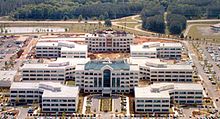
Redstone Arsenal is a United States Army base adjacent to Huntsville, Alabama in the Wheeler National Wildlife Refuge. It is a census-designated place in Madison County, Alabama, United States and is part of the Huntsville-Decatur Combined Statistical Area. The Arsenal is a host to over 75 tenant agencies including the Department of Defense (DoD), Department of Justice (DOJ), the Federal Bureau of Investigation (FBI), and NASA's largest field center, the Marshall Space Flight Center.

The George C. Marshall Space Flight Center (MSFC), located in Redstone Arsenal, Alabama, is the U.S. government's civilian rocketry and spacecraft propulsion research center. As the largest NASA center, MSFC's first mission was developing the Saturn launch vehicles for the Apollo program. Marshall has been the lead center for the Space Shuttle main propulsion and external tank; payloads and related crew training; International Space Station (ISS) design and assembly; computers, networks, and information management; and the Space Launch System. Located on the Redstone Arsenal near Huntsville, MSFC is named in honor of General of the Army George C. Marshall.

The Army Ballistic Missile Agency (ABMA) was formed to develop the U.S. Army's first large ballistic missile. The agency was established at Redstone Arsenal on 1 February 1956, and commanded by Major General John B. Medaris with Wernher von Braun as technical director.

The PGM-11 Redstone was the first large American ballistic missile. A short-range ballistic missile (SRBM), it was in active service with the United States Army in West Germany from June 1958 to June 1964 as part of NATO's Cold War defense of Western Europe. It was the first US missile to carry a live nuclear warhead, in the 1958 Pacific Ocean weapons test, Hardtack Teak.

The MGM-29 Sergeant was an American short-range, solid fuel, surface-to-surface missile developed by the Jet Propulsion Laboratory. The missiles were built by Sperry Utah Company. The Sergeant was the third and last in a series of JPL rockets for the US Army whose names correspond to the progression in Army enlisted ranks, starting with Private and Corporal.

Letterkenny Army Depot, the Center of Industrial and Technical Excellence (CITE) for Air Defense and Tactical Missile Systems, was established in early 1942. Its leadership began recruiting civilian personnel in July 1942.

The United States Army Ordnance Corps, formerly the United States Army Ordnance Department, is a sustainment branch of the United States Army, headquartered at Fort Gregg-Adams, Virginia. The broad mission of the Ordnance Corps is to supply Army combat units with weapons and ammunition, including at times their procurement and maintenance. Along with the Quartermaster Corps and Transportation Corps, it forms a critical component of the U.S. Army logistics system.
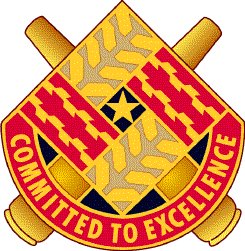
The United States Army Tank-automotive and Armaments Command (TACOM), and its subordinate Life Cycle Management Command (LCMC), headquartered at the Detroit Arsenal in Warren, Michigan, is part of the United States Army Materiel Command (AMC).

The U.S. Army Combat Capabilities Development Command Aviation & Missile Center (AvMC), formerly known as the U.S. Army Aviation and Missile Research, Development and Engineering Center (AMRDEC), a part of the U.S. Army Research, Development, and Engineering Command (RDECOM) — now DEVCOM, is primarily a civilian organization tasked to provide research, development and engineering technology and services to support U.S. Army aviation and missile platforms. AvMC conducts research, promotes development, engineering and simulation laboratories and facilities used to develop and improve aviation and missile components, subsystems and systems.

The U.S. Army Materiel Command (AMC) is the primary provider of materiel to the United States Army. The Command's mission includes the management of installations, as well as maintenance and parts distribution. It was established on 8 May 1962 and was activated on 1 August of that year as a major field command of the U.S. Army. Lieutenant General Frank S. Besson, Jr., who directed the implementation of the Department of Army study that recommended creation of a "materiel development and logistics command", served as its first commander.

The Combat Capabilities Development Command, is a subordinate command of the U.S. Army Futures Command. RDECOM was tasked with "creating, integrating, and delivering technology-enabled solutions" to the U.S. Army. It is headquartered at Aberdeen Proving Ground in Maryland.

The Redstone Test Stand or Interim Test Stand was used to develop and test fire the Redstone missile, Jupiter-C sounding rocket, Juno I launch vehicle and Mercury-Redstone launch vehicle. It was declared an Alabama Historic Civil Engineering Landmark in 1979 and a National Historic Landmark in 1985. It is located at NASA's George C. Marshall Space Flight Center (MSFC) in Huntsville, Alabama on the Redstone Arsenal, designated Building 4665. The Redstone missile was the first missile to detonate a nuclear weapon. Jupiter-C launched to test components for the Jupiter missile. Juno I put the first American satellite Explorer 1 into orbit. Mercury Redstone carried the first American astronaut Alan Shepard into space. The Redstone earned the name "Old Reliable" because of this facility and the improvements it made possible.
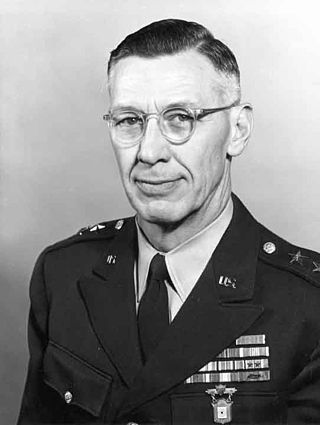
Major General Holger Nelson Toftoy was a United States Army career officer instrumental to the development of the United States' early rocketry after World War II, such as the Redstone missile. He persuaded senior officers to bring German scientists to the US after the war, to make use of their expertise, and supervised the relocation of more than 119 scientists.

The United States Army Security Assistance Command (USASAC) – "the 'Army's Face to the World'" - implements security assistance programs, including Foreign Military Sales (FMS) of defense articles and services to eligible foreign governments. In addition, USASAC is responsible for the US Army's security assistance information management and financial policy and provides logistics guidance to the army's security assistance community. The command also supports the U.S. government's emergency assistance, humanitarian relief, and Operations Other Than War, including peacekeeping operations by the United Nations. The USASAC traces its origins to the Army's technical service era, and was designated a major subordinate command (MSC) of the U.S. Army Materiel Command (AMC) in 1975. Since its formation, USASAC has supported major US military operations and supported international peacekeeping and humanitarian efforts. The USASAC's motto is "Strength in Cooperation."
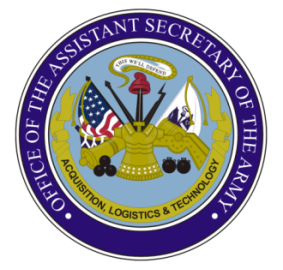
The Office of the United States Assistant Secretary of the Army for Acquisition, Logistics, and Technology (ASA(ALT) pronounced A-salt) is known as OASA(ALT). OASA(ALT) serves, when delegated, as the Army Acquisition Executive, the Senior Procurement Executive, the Science Advisor to the Secretary of the Army, and as the senior research and development official for the Department of the Army. The OASA(ALT) also has the principal responsibility for all Department of the Army matters related to logistics.
Carl Ernest Duckett was the founder of the Central Intelligence Agency's science and technology operations.

Lieutenant General (Ret.) August Schomburg was the Commander of the United States Army Ballistic Missile Command, and later Commandant of the Industrial College of the Armed Forces. He retired from Active Duty military service in 1967, and died in 1972. He is buried at Arlington National Cemetery. His wife Fern Wynne Schomburg died in 1996.
The Pershing Project Manager's Office (PPMO) was the U.S. Army agency responsible for the systems management and engineering of the Pershing missile systems.

Major General Clark W. LeMasters Jr. is a serving general officer in the United States Army and serves as the 35th Commanding General of the U.S. Army Tank-automotive and Armaments Command Life Cycle Management Command. Previously, he served as the 36th Chief of Ordnance for the U.S. Army and Commandant of the United States Army Ordnance School at Fort Lee, Virginia.
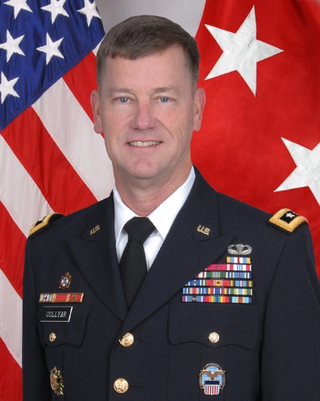
Major General Lynn A. Collyar is a retired general officer in the United States Army and served as the Commanding General, U.S. Army Aviation & Missile Command between from 2012 to 2014. Prior to this assignment, he served as the 35th Chief of Ordnance and Commandant of the U.S. Army Ordnance School at Aberdeen Proving Ground, Maryland and Fort Lee, Virginia.
